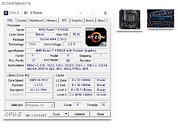Thursday, August 20th 2020

AMD Renoir Powers the World Record of DDR4 Memory Overclock: 6,666 MHz
A new HWBot entry has proven what some thought impossible years ago: AMD apparently features the best memory controller in the x86 consumer space. A user going by the alias Bianbao XE achieved a 6,666 MHz frequency on a single stick of Crucial Ballistix Max. The stick's original rating is for a mere 2,666 MHz - doesn't that put things in perspective?
Another thing that puts things into perspective is that the support for such an overclocking feat was a ROG Strix B550-I Gaming motherboard (min-ITX means smaller tracing distance between CPU and memory, and thus higher signal integrity) paired with none other than AMD's Ryzen 7 4700GE 'Renoir'. The APU was underclocked and overvolted - a technique that aimed to increase stability of the memory controller whilst also reducing operating temperatures (balancing the higher voltage and lower frequency). Of course, memory timings were loosened to achieve this feat (timings of 30-27-27-58 aren't what you'd usually like to see), but then again, this wasn't meant to power the utmost memory performance - only the highest frequency. And that was definitely achieved.
Sources:
Tom's Hardware, HWBot
Another thing that puts things into perspective is that the support for such an overclocking feat was a ROG Strix B550-I Gaming motherboard (min-ITX means smaller tracing distance between CPU and memory, and thus higher signal integrity) paired with none other than AMD's Ryzen 7 4700GE 'Renoir'. The APU was underclocked and overvolted - a technique that aimed to increase stability of the memory controller whilst also reducing operating temperatures (balancing the higher voltage and lower frequency). Of course, memory timings were loosened to achieve this feat (timings of 30-27-27-58 aren't what you'd usually like to see), but then again, this wasn't meant to power the utmost memory performance - only the highest frequency. And that was definitely achieved.


25 Comments on AMD Renoir Powers the World Record of DDR4 Memory Overclock: 6,666 MHz
That is probably the coolest record in 2020 :P
There are rumours of a new APU that has more Vega CUs, but nothing concrete yet.
Problem with Ryzens has not been the memory controller itself, it's the memory bus speed being tied to IF speed and the latter has been the limiting factor. Zen2 and Renoir benefit from dividers and a bunch of tweaks to get these out of the way. Don't get me wrong, Renoir's memory controller improvements are awesome. But I am seriously curious where the actual bottleneck is these days.
It says so right in the article. The 4700GE is underclocked to a silly extent, and presumably VSOC is overvolted to bolster the memory controller, the latter being in and of itself is a major longevity concern.
B-die's still king for actually stable daily performance between 4000 and 5000MT/s, however. Rev.E doesn't go nearly tight enough on most timings.
Matisse (and presumably Renoir from the news as of late) IMC is getting to be superior to the Coffee Lake IMC, although Comet Lake is markedly improved. Unfortunately for us, Infinity Fabric exists, which reduces uncoupled DRAM on Ryzen to nothing more than validation stunts, 100% of the time.
*ba dum tss*
Otherwise I haven't been been interesting in extreme overclocking, especially RAM OC, in years, but I still always wonder how long it will take for those to be typical consumer speeds in RAM.